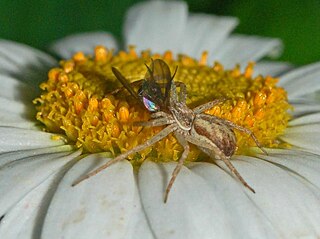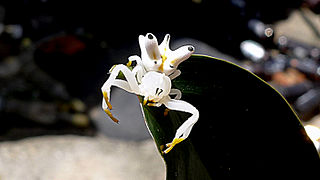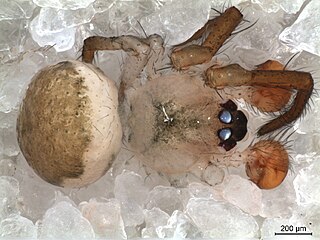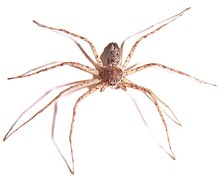
The Thomisidae are a family of spiders, including about 170 genera and over 2,100 species. The common name crab spider is often linked to species in this family, but is also applied loosely to many other families of spiders. Many members of this family are also known as flower spiders or flower crab spiders.

Wolf spiders are members of the family Lycosidae. They are robust and agile hunters with excellent eyesight. They live mostly in solitude, hunt alone, and usually do not spin webs. Some are opportunistic hunters, pouncing upon prey as they find it or chasing it over short distances; others wait for passing prey in or near the mouth of a burrow.

Huntsman spiders, members of the family Sparassidae, are known by this name because of their speed and mode of hunting. They are also called giant crab spiders because of their size and appearance. Larger species sometimes are referred to as wood spiders, because of their preference for woody places. In southern Africa the genus Palystes are known as rain spiders or lizard-eating spiders. Commonly, they are confused with baboon spiders from the Mygalomorphae infraorder, which are not closely related.

Ground spiders comprise Gnaphosidae, the seventh largest spider family with over 2,000 described species in over 100 genera distributed worldwide. There are 105 species known to central Europe, and common genera include Gnaphosa, Drassodes, Micaria, Cesonia, Zelotes and many others. They are closely related to Clubionidae. At present, no ground spiders are known to be seriously venomous to humans.

Corinnidae is a family of araneomorph spiders, sometimes called corinnid sac spiders. The family, like other "clubionoid" families, has a confusing taxonomic history. Once it was a part of the large catch-all taxon Clubionidae, now very much smaller. The original members of the family are apparently similar only in that they have eight eyes arranged in two rows, conical anterior spinnerets that touch and are generally wandering predators that build silken retreats, or sacs, usually on plant terminals, between leaves, under bark or under rocks.

Thanatus is a genus of false crab spiders described by Carl Ludwig Koch in 1837, belonging to the order Araneae, family Philodromidae.

Nemesiidae, also known as funnel-web trapdoor spiders, is a family of mygalomorph spiders first described by Eugène Simon in 1889, and raised to family status in 1985. Before becoming its own family, it was considered part of "Dipluridae".

Castianeira is a genus of ant-like corinnid sac spiders first described by Eugen von Keyserling in 1879. They are found in Eurasia, Africa, and the Americas, but are absent from Australia. Twenty-six species are native to North America, and at least twice as many are native to Mexico and Central America.

Tibellus is a genus of slender crab spiders described by Simon in 1875, belonging to the order Araneae, family Philodromidae. Species of this genus are present in Eurasia, Africa, Americas and Australia.

Olios is the largest genus of huntsman spiders, containing 166 species. They are found throughout the world, with most species occurring in hot countries. The genus was first described by Charles Athanase Walckenaer in 1837.

Synema is a genus of spider in the family Thomisidae, found in most parts of the world.
Epidius is a genus of crab spiders that was first described by Tamerlan Thorell in 1877. It is a senior synonym of Pothaeus.
Pulchellodromus is a genus of running crab spiders that was first separated from Philodromus by J. Wunderlich in 2012.

Rhomphaea is a genus of comb-footed spiders that was first described by Ludwig Carl Christian Koch in 1872.
Acentroscelus is a genus of South American crab spiders that was first described by Eugène Louis Simon in 1886. It is a senior synonym of Whittickius.

Epicadus is a genus of crab spiders that was first described by Eugène Louis Simon in 1895. It is considered a senior synonym of Tobias.

Onocolus is a genus of South American crab spiders first described by Eugène Simon in 1895. It is considered a senior synonym of Paronocolus.
Kryptochroma is a genus of South American bark-dwelling crab spiders erected by M. Machado, R. Viecelli, and C. Guzati in 2021 after a phylogenetic analysis showed that Stephanopis contained two distinctly different clades. The genus was created for the "pentacantha" clade, as well as for several newly described species.
















